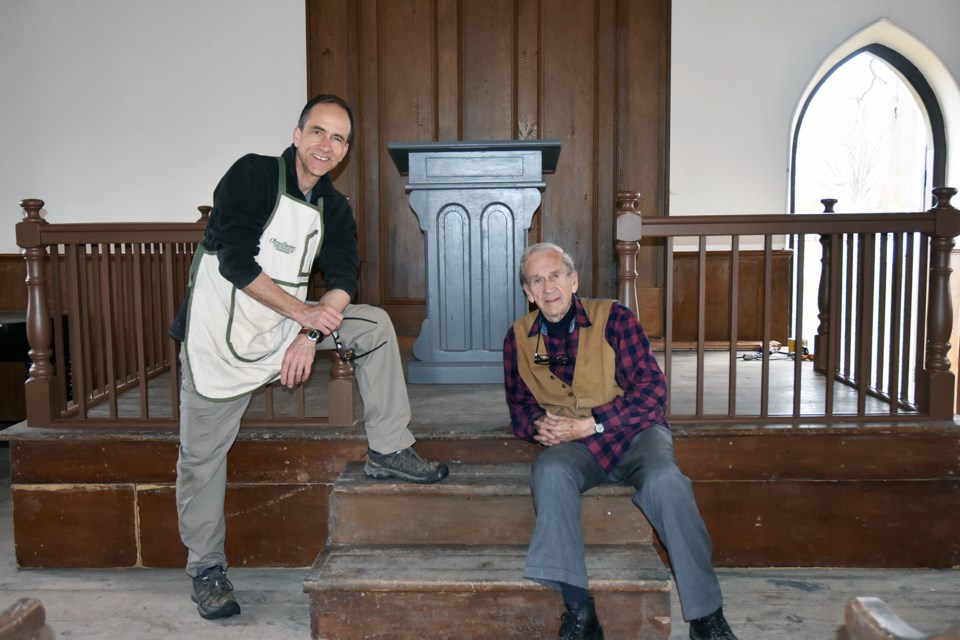Sometimes, it takes a village to preserve heritage and history.
That’s true for the Auld Kirk, a church founded in the early 1820s by the first settlers in West Gwillimbury Township. It has taken town council, the efforts of the BWG Local History Association and Scotch Settlement Historical Association, and volunteers like Dr. David Chambers and his son Bruce, to preserve and restore the historic building.
The Auld Kirk, a simple brick structure on the 6th Line BWG just west of Bradford, was built in 1869 – replacing earlier log and then frame church buildings. But divisions in the Presbyterian church meant that the church closed to regular worship not long after it was completed.
It sat vacant for decades, maintained by local families with a connection to the Scotch Settlement pioneers – 17 families who returned from Lord Selkirk’s failed Red River colony in Manitoba to farm in West Gwillimbury in 1819, and built the first church on the site in 1822. Many of those pioneers and their descendants are buried in the adjacent cemetery.
Heavy wooden shutters, added in the 1920s, not only kept out the curious but helped to preserve the wooden window frames and the interior - but over the years, time and the weather began to take a toll.
It was the BWG Local History Association that made a push to have the church designated as a heritage site, and contributed funds, raised through annual heritage house tours, for basic repairs that included a new roof and restoration work. They also acquired a grant, funding a survey of the cemetery using ground-penetrating radar, to locate long-lost burial sites.
It was town council that eventually acquired the building – tracing the ownership from the Presbyterian to the United Church – and gave it the protection of heritage designation in 2017.
And it has been woodworker Bruce Chambers and his father David, local historian and antiquarian, who have helped to restore the building and give it new life.
Bruce Chambers, of Bruce Chambers Period Furniture Ltd., was commissioned by the Local History Association in 2015 to replace the front and back doors, which had become weathered and rotted.
In 2018, he rebuilt the windows, again with funding from the Association – adding new protective weather screens that have made it possible to dispense with the shutters.
“It’s just transformed the building,” Chambers said, allowing in light and making the character, charm and proportions of the simple church more evident.
Over the past few weeks the Chambers, father and son, have been working on a new project at the church: adding a wooden railing to the existing stage, a raised platform about 18 inches above floor level.
“We all looked at it, and decided that was what was next, just for safety,” explained Bruce. In several events held at the Auld Kirk in recent years, the stage has been used by choirs, speakers and performers – and there have been concerns over the lack of a railing or balustrade, to prevent falls.
With the approval of the town, Bruce and his father designed new railings that are in keeping with the original woodworking within the church.
“We took the design from a mud blockhouse just the other side of the 400, from about the same period,” Bruce noted.
He and his father also looked at the 5th Line Presbyterian Church, but found that the solid railing there was much later in origin, and not appropriate to the 1860s and the Auld Kirk.
With a design in hand, Bruce had to take apart the old stage and take up floorboards to ensure that the structure was solid, then rebuild the stage and install the new railing, painted to match the existing wood trim.
There is no sign that the stage ever had a balustrade, but it’s a tribute to Chambers’ work that the railing looks as if it has always been in place.
“This was all put together the way a traditional balustrade is made,” said David, with every post hand-turned on an 1870s lathe.
“These aren’t Home Depot posts,” agreed Bruce.
In addition to time spent on research and design, it has taken about a week to prepare the pieces, and another week or more to complete the installation.
“It’s worth it,” insisted David. “This is a very important historic site. This is where Simcoe County began.”
Outside the church, restoration has also been underway on the cemetery itself, unearthing and repairing the stones, many of which date back to the 1830s, and provide evidence of the harsh life and difficult challenges faced by the pioneering families.
David Chambers and fellow historian Vaughan Harris, who has also been part of the restoration of the Wilson’s Hill Pioneer Cemetery, work on the cemetery once a week.
“We had to dig some of the stones out of the ground,” noted Chambers – also unearthing and restoring the iron rails, chains and swags that used to surround family burial plots.
The work is ongoing and “worthwhile,” he said, expressing the hope that the Auld Kirk will become a site that can be regularly used for special events, appreciated as a significant part of local history by more and more residents.
There is also the beauty of the site and the cemetery, located on a hill planted with oak trees, with sweeping views of the surrounding farmland.
“In the summer on a nice day, I come here with my book and sit down,” said David. “I just love it… It’s an oasis, that’s what it is.”
It’s also a labour of love, restoring and preserving the Auld Kirk for generations to come.



